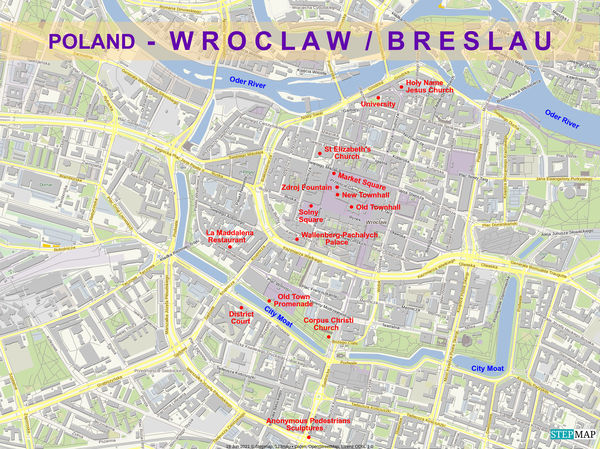North European Plain 75 - Poland/Wroclaw|Breslau 1- Intro & walk to old city center
Jul 2, 2021 11:04:03 #
After leaving Poznan and an uneventful drive of about 2 hours covering 180 km/110 mi, we arrived in WROCLAW/BRESLAU, our last city to visit in Poland. I was not feeling well, the throat infection I probably picked up in Gdansk and which started to bother me in Poznan really made my life miserable: I had problems swallowing and hence ate very little, rendering me sort of weak. It became clear that I had to see a doctor, thus with the help of our hotel reception staff, we made an appointment right upon arrival, but could see the doctor only at 8:00 pm. We used the afternoon to do our usual tour of the city, concentrating again as in Poznan, on its Market Square (Rynek we Wroclawiu).
INTRODUCTION
Wrocław is the largest city in the historical region of Silesia/Schlesien. It lies on the banks of the River Oder in the Silesian Lowlands of Central Europe, roughly 350 km/220 mi from the Baltic Sea to the north and 40 km/25 mi from the Sudeten Mountains to the south. The population of Wrocław in 2020 was 640,000, with a further 1.25 million residing in the metropolitan area. Wrocław is the historical capital of Silesia and Lower Silesia. The history of the city dates back over a thousand years; at various times, it has been part of the Kingdom of Poland, the Kingdom of Bohemia, the Kingdom of Hungary, the Habsburg Monarchy of Austria, the Kingdom of Prussia and Germany. Wrocław became part of Poland again in 1945 as part of the so-called Recovered Territories, the result of extensive border changes and expulsions after the Second World War. Wrocław is a university city with a student population of over 130,000, making it arguably one of the most youth-oriented cities in the country. Since the beginning of the 20th century, the University of Wrocław, previously Breslau University, has produced 9 Nobel Prize laureates and is renowned for its high quality of teaching. Wrocław also possesses numerous historical landmarks, including the Main Market Square, Cathedral Island and the Centennial Hall, which is listed as a UNESCO World Heritage Site.
HISTORY
EARLY HISTORY - In ancient times, there was a place called Budorigum at or near the site of Wrocław. It was already mapped on the map of AD 142–147 by the Roman geographer/astronomer Claudius Ptolemy. Settlements in the area existed from the 6th century onward during the migration period. Wrocław originated at the intersection of two trade routes, the Via Regia and the Amber Road. The city was first recognized in the 10th century as Vratislavia on account of the Bohemian duke Vratislav I's stronghold there, hence the name. When in 985, Duke Mieszko I of Poland conquered Silesia, Vratislavia's polonised form over time became Wrocław. The town was mentioned explicitly in the year 1000 AD in connection with its promotion to an episcopal see during the Congress of Gniezno.
MIDDLE AGES - The city became a commercial center and expanded onto the left bank of the River Oder. Around 1000, the town had about 1,000 inhabitants. The medieval chronicle, Gesta principum Polonorum named Wrocław, along with Krakow and Sandomierz, as one of three capitals of the Polish Kingdom. By 1139, while the city was largely Polish, it also had communities of Bohemians (Czechs), Germans, Walloons and Jews. In the 13th century, Wrocław was the political center of the divided Polish kingdom. In April 1241, during the First Mongol invasion of Poland the city was abandoned by its inhabitants and burnt down for strategic reasons. During the battles with the Mongols Wrocław Castle was successfully defended by Henry II the Pious. After the Mongol invasion the town was partly populated by German settlers who, in the ensuing centuries, gradually became its dominant population. The city, however, retained its multi-ethnic character, a reflection of its importance as a trading post on the junction of the Via Regia and the Amber Road.
With the influx of settlers the town expanded and in 1242 came under German town law. The city council used both Latin and German, and the early forms of the name "Breslau", the German name of the city, appeared for the first time in its written records. Polish gradually ceased to be used in the town books. The enlarged town covered around 60 hectares (150 acres), and the new main market square, surrounded by timber-frame houses, became the trade center of the town. The city gained Magdeburg rights in 1261. While the Polish Piast dynasty remained in control of the region, the ability of the city council to govern itself independently increased. Wrocław, which for 350 years had been mostly under Polish hegemony, fell in 1335 to the Kingdom of Bohemia, then a part of the Holy Roman Empire. Between 1342 and 1344, two fires destroyed large parts of the city. In 1387 the city joined the Hanseatic League. On 5 June 1443, the city was rocked by an earthquake, estimated at ca. 6 on the Richter scale, which destroyed or seriously damaged many of its buildings. Between 1469 and 1490, Wrocław was part of the Kingdom of Hungary. In 1474, after almost a century, the city left the Hanseatic League and the city was besieged by combined Polish-Czech forces. In December 1474 a ceasefire was signed according to which the city remained under Hungarian rule.
RENAISSANCE AND THE REFORMATION - The Protestant Reformation reached the city in 1518 and it converted to the new rite. However, from 1526 Silesia was ruled by the Catholic House of Habsburg. In 1618, it supported the Bohemian Revolt out of fear of losing the right to religious freedom. During the ensuing Thirty Years' War, the city was occupied by Saxon and Swedish troops and lost thousands of inhabitants to the plague. The Emperor brought in the Counter-Reformation by encouraging Catholic orders to settle in the city, starting in 1610 with the Franciscans, followed by the Jesuits, then Capuchins, and finally Ursuline nuns in 1687. These orders erected buildings, which shaped the city's appearance until 1945. At the end of the Thirty Years' War, however, it was one of only a few Silesian cities to stay Protestant. The Polish Municipal school opened in 1666 and lasted until 1766. Precise record-keeping of births and deaths by the city fathers led to the use of their data for analysis of mortality, these tables and analysis, published in 1693, are considered to be the first true actuarial tables, and thus the foundation of modern actuarial science. During the Counter-Reformation, the intellectual life of the city flourished, as the Protestant bourgeoisie lost some of its dominance to the Catholic orders as patrons of the arts.
INDUSTRIAL AGE - During the Napoleonic Wars, Breslau was occupied by the Confederation of the Rhine army. The fortifications of the city were levelled, and monasteries and cloisters were seized. The Confederation increased prosperity in Silesia and in the city. The removal of fortifications opened room for the city to expand beyond its former limits. Breslau became an important railway hub and industrial center. The reconstructed university served as a major center of science; Johannes Brahms later wrote his Academic Festival Overture to thank the university for an honorary doctorate awarded in 1879. In 1821, the Diocese of Breslau withdrew from dependence on the Polish archbishopric of Gniezno, and Breslau became an exempt see. In 1854, the Jewish Theological Seminary opened. The institution was the first modern rabbinical seminary in Central Europe. In 1863 the brothers Karl and Louis Stangen founded the travel agency Stangen, the second travel agency in the world.
After Hitler's appointment as German Chancellor in 1933, political enemies of the Nazis were persecuted, and their institutions closed or destroyed. The Gestapo began actions against Polish and Jewish students, Communists, Social Democrats, and trade unionists. Arrests were made for speaking Polish in public, and in 1938 the Nazi-controlled police destroyed the Polish cultural center. In June 1939, Polish students were expelled from the university. Also many other people seen as "undesirable" by the Third Reich were sent to concentration camps. A network of concentration camps and forced labor camps was established around Breslau to serve industrial concerns. Tens of thousand of forced laborers were imprisoned there.
WWII TO PRESENT - During the invasion of Poland in September 1393, which started WWII, the Germans carried out mass arrests of local Polish activists and banned Polish organizations. For most of the war, the fighting did not affect the city. In February 1945 the Soviet Army approached the city. The Germans declared the city a fortress to be held at all costs, but finally lifted a ban on the evacuation of women and children when it was almost too late. During this poorly organized evacuation in January 1945, 18,000 people froze to death in icy snowstorms. By the end of the Battle of Breslau (February–May 1945), half the city had been destroyed. An estimated 40,000 civilians lay dead in the ruins of homes and factories. After a siege of nearly three months, Fortress Breslau capitulated to the Red Army on 6 May 1945, two days before the end of the war. Following the Yalta Conference held in February 1945 where the new geopolitics of Central Europe were decided, the terms of the Potsdam Conference decreed that with almost all of Lower Silesia, the city would become part of Poland in exchange for Poland's loss of the massive territory in the east, which was annexed by the Soviet Union. The Polish name of "Wrocław" was declared official.
Following World War II, the region became part of Poland under territorial changes defined by the Potsdam Agreement. The town's German inhabitants who had not fled, or who had safely returned to their home town after the war officially had ended, were expelled between 1945 and 1949 in accordance to the Potsdam Agreement and were settled in the Soviet occupation zone or in the Allied Occupation Zones in the remainder of Germany. The Polish population dramatically increased by the resettlement of Poles during postwar population transfers as a result of the forced deportations from Polish lands annexed by the Soviet Union in the east region. A small German minority (about 1,000 people, or 2% of the population) remains in the city, so that today the relation of Polish to German population is the reverse of what it was a 100 years ago. Traces of the German past, such as inscriptions and signs, have been removed. Wrocław is today a unique European city of mixed heritage, with architecture influenced by Bohemian, Austrian, and Prussian traditions, such as Silesian Gothic and its Baroque style of court builders of Habsburg Austria.
------------------------------------------------------------------------------------------------------------------------------
In this first set, we walk from our hotel located just at the edge of the center towards the center of town, crossing the Fosa Miejska, city moat of Wroclaw, see an interesting group of sculptures sinking into the underground and emerging at the other side of the crosswalk, and skirt some interesting buildings to arrive at the Solny Square diagonally across from the famous Market Square.
ANONYMOUS PEDESTRIANS - The sculpture group "Anonymous Pedestrians" is one of the most unique monuments in the city. This unusual sculpture consists of five human figures "walking in" under the pavement and "coming out" of it on the other side of the street. According to many experts of art, this work of Jerzy Kalina shows the passing of regular citizens to free Poland in an avant-garde way. In 2015, the architectonic magazine "Arch-20" recognized it as one of the most creative monuments in recent years.
Notes
TRIP INFO: Set # 1 provides a brief introduction, maps and information for the entire series. Find it at:
https://www.uglyhedgehog.com/t-693834-1.html
DETAILS ON POLAND: Set 56 provides an intro, see: https://www.uglyhedgehog.com/t-700547-1.html
EARLIER POSTS of this series: Access my topic list, the new posts are listed in reverse chronological order:
https://www.uglyhedgehog.com/user-topic-list?usernum=45105
Thank you for visiting, I recommend viewing the downloads and look forward to your comments and questions.
.
INTRODUCTION
Wrocław is the largest city in the historical region of Silesia/Schlesien. It lies on the banks of the River Oder in the Silesian Lowlands of Central Europe, roughly 350 km/220 mi from the Baltic Sea to the north and 40 km/25 mi from the Sudeten Mountains to the south. The population of Wrocław in 2020 was 640,000, with a further 1.25 million residing in the metropolitan area. Wrocław is the historical capital of Silesia and Lower Silesia. The history of the city dates back over a thousand years; at various times, it has been part of the Kingdom of Poland, the Kingdom of Bohemia, the Kingdom of Hungary, the Habsburg Monarchy of Austria, the Kingdom of Prussia and Germany. Wrocław became part of Poland again in 1945 as part of the so-called Recovered Territories, the result of extensive border changes and expulsions after the Second World War. Wrocław is a university city with a student population of over 130,000, making it arguably one of the most youth-oriented cities in the country. Since the beginning of the 20th century, the University of Wrocław, previously Breslau University, has produced 9 Nobel Prize laureates and is renowned for its high quality of teaching. Wrocław also possesses numerous historical landmarks, including the Main Market Square, Cathedral Island and the Centennial Hall, which is listed as a UNESCO World Heritage Site.
HISTORY
EARLY HISTORY - In ancient times, there was a place called Budorigum at or near the site of Wrocław. It was already mapped on the map of AD 142–147 by the Roman geographer/astronomer Claudius Ptolemy. Settlements in the area existed from the 6th century onward during the migration period. Wrocław originated at the intersection of two trade routes, the Via Regia and the Amber Road. The city was first recognized in the 10th century as Vratislavia on account of the Bohemian duke Vratislav I's stronghold there, hence the name. When in 985, Duke Mieszko I of Poland conquered Silesia, Vratislavia's polonised form over time became Wrocław. The town was mentioned explicitly in the year 1000 AD in connection with its promotion to an episcopal see during the Congress of Gniezno.
MIDDLE AGES - The city became a commercial center and expanded onto the left bank of the River Oder. Around 1000, the town had about 1,000 inhabitants. The medieval chronicle, Gesta principum Polonorum named Wrocław, along with Krakow and Sandomierz, as one of three capitals of the Polish Kingdom. By 1139, while the city was largely Polish, it also had communities of Bohemians (Czechs), Germans, Walloons and Jews. In the 13th century, Wrocław was the political center of the divided Polish kingdom. In April 1241, during the First Mongol invasion of Poland the city was abandoned by its inhabitants and burnt down for strategic reasons. During the battles with the Mongols Wrocław Castle was successfully defended by Henry II the Pious. After the Mongol invasion the town was partly populated by German settlers who, in the ensuing centuries, gradually became its dominant population. The city, however, retained its multi-ethnic character, a reflection of its importance as a trading post on the junction of the Via Regia and the Amber Road.
With the influx of settlers the town expanded and in 1242 came under German town law. The city council used both Latin and German, and the early forms of the name "Breslau", the German name of the city, appeared for the first time in its written records. Polish gradually ceased to be used in the town books. The enlarged town covered around 60 hectares (150 acres), and the new main market square, surrounded by timber-frame houses, became the trade center of the town. The city gained Magdeburg rights in 1261. While the Polish Piast dynasty remained in control of the region, the ability of the city council to govern itself independently increased. Wrocław, which for 350 years had been mostly under Polish hegemony, fell in 1335 to the Kingdom of Bohemia, then a part of the Holy Roman Empire. Between 1342 and 1344, two fires destroyed large parts of the city. In 1387 the city joined the Hanseatic League. On 5 June 1443, the city was rocked by an earthquake, estimated at ca. 6 on the Richter scale, which destroyed or seriously damaged many of its buildings. Between 1469 and 1490, Wrocław was part of the Kingdom of Hungary. In 1474, after almost a century, the city left the Hanseatic League and the city was besieged by combined Polish-Czech forces. In December 1474 a ceasefire was signed according to which the city remained under Hungarian rule.
RENAISSANCE AND THE REFORMATION - The Protestant Reformation reached the city in 1518 and it converted to the new rite. However, from 1526 Silesia was ruled by the Catholic House of Habsburg. In 1618, it supported the Bohemian Revolt out of fear of losing the right to religious freedom. During the ensuing Thirty Years' War, the city was occupied by Saxon and Swedish troops and lost thousands of inhabitants to the plague. The Emperor brought in the Counter-Reformation by encouraging Catholic orders to settle in the city, starting in 1610 with the Franciscans, followed by the Jesuits, then Capuchins, and finally Ursuline nuns in 1687. These orders erected buildings, which shaped the city's appearance until 1945. At the end of the Thirty Years' War, however, it was one of only a few Silesian cities to stay Protestant. The Polish Municipal school opened in 1666 and lasted until 1766. Precise record-keeping of births and deaths by the city fathers led to the use of their data for analysis of mortality, these tables and analysis, published in 1693, are considered to be the first true actuarial tables, and thus the foundation of modern actuarial science. During the Counter-Reformation, the intellectual life of the city flourished, as the Protestant bourgeoisie lost some of its dominance to the Catholic orders as patrons of the arts.
INDUSTRIAL AGE - During the Napoleonic Wars, Breslau was occupied by the Confederation of the Rhine army. The fortifications of the city were levelled, and monasteries and cloisters were seized. The Confederation increased prosperity in Silesia and in the city. The removal of fortifications opened room for the city to expand beyond its former limits. Breslau became an important railway hub and industrial center. The reconstructed university served as a major center of science; Johannes Brahms later wrote his Academic Festival Overture to thank the university for an honorary doctorate awarded in 1879. In 1821, the Diocese of Breslau withdrew from dependence on the Polish archbishopric of Gniezno, and Breslau became an exempt see. In 1854, the Jewish Theological Seminary opened. The institution was the first modern rabbinical seminary in Central Europe. In 1863 the brothers Karl and Louis Stangen founded the travel agency Stangen, the second travel agency in the world.
After Hitler's appointment as German Chancellor in 1933, political enemies of the Nazis were persecuted, and their institutions closed or destroyed. The Gestapo began actions against Polish and Jewish students, Communists, Social Democrats, and trade unionists. Arrests were made for speaking Polish in public, and in 1938 the Nazi-controlled police destroyed the Polish cultural center. In June 1939, Polish students were expelled from the university. Also many other people seen as "undesirable" by the Third Reich were sent to concentration camps. A network of concentration camps and forced labor camps was established around Breslau to serve industrial concerns. Tens of thousand of forced laborers were imprisoned there.
WWII TO PRESENT - During the invasion of Poland in September 1393, which started WWII, the Germans carried out mass arrests of local Polish activists and banned Polish organizations. For most of the war, the fighting did not affect the city. In February 1945 the Soviet Army approached the city. The Germans declared the city a fortress to be held at all costs, but finally lifted a ban on the evacuation of women and children when it was almost too late. During this poorly organized evacuation in January 1945, 18,000 people froze to death in icy snowstorms. By the end of the Battle of Breslau (February–May 1945), half the city had been destroyed. An estimated 40,000 civilians lay dead in the ruins of homes and factories. After a siege of nearly three months, Fortress Breslau capitulated to the Red Army on 6 May 1945, two days before the end of the war. Following the Yalta Conference held in February 1945 where the new geopolitics of Central Europe were decided, the terms of the Potsdam Conference decreed that with almost all of Lower Silesia, the city would become part of Poland in exchange for Poland's loss of the massive territory in the east, which was annexed by the Soviet Union. The Polish name of "Wrocław" was declared official.
Following World War II, the region became part of Poland under territorial changes defined by the Potsdam Agreement. The town's German inhabitants who had not fled, or who had safely returned to their home town after the war officially had ended, were expelled between 1945 and 1949 in accordance to the Potsdam Agreement and were settled in the Soviet occupation zone or in the Allied Occupation Zones in the remainder of Germany. The Polish population dramatically increased by the resettlement of Poles during postwar population transfers as a result of the forced deportations from Polish lands annexed by the Soviet Union in the east region. A small German minority (about 1,000 people, or 2% of the population) remains in the city, so that today the relation of Polish to German population is the reverse of what it was a 100 years ago. Traces of the German past, such as inscriptions and signs, have been removed. Wrocław is today a unique European city of mixed heritage, with architecture influenced by Bohemian, Austrian, and Prussian traditions, such as Silesian Gothic and its Baroque style of court builders of Habsburg Austria.
------------------------------------------------------------------------------------------------------------------------------
In this first set, we walk from our hotel located just at the edge of the center towards the center of town, crossing the Fosa Miejska, city moat of Wroclaw, see an interesting group of sculptures sinking into the underground and emerging at the other side of the crosswalk, and skirt some interesting buildings to arrive at the Solny Square diagonally across from the famous Market Square.
ANONYMOUS PEDESTRIANS - The sculpture group "Anonymous Pedestrians" is one of the most unique monuments in the city. This unusual sculpture consists of five human figures "walking in" under the pavement and "coming out" of it on the other side of the street. According to many experts of art, this work of Jerzy Kalina shows the passing of regular citizens to free Poland in an avant-garde way. In 2015, the architectonic magazine "Arch-20" recognized it as one of the most creative monuments in recent years.
Notes
TRIP INFO: Set # 1 provides a brief introduction, maps and information for the entire series. Find it at:
https://www.uglyhedgehog.com/t-693834-1.html
DETAILS ON POLAND: Set 56 provides an intro, see: https://www.uglyhedgehog.com/t-700547-1.html
EARLIER POSTS of this series: Access my topic list, the new posts are listed in reverse chronological order:
https://www.uglyhedgehog.com/user-topic-list?usernum=45105
Thank you for visiting, I recommend viewing the downloads and look forward to your comments and questions.
.
1 - Title page for Wroclaw/Breslau with a brief introduction of the city on the background of a scene showing the Market Square of Wroclaw
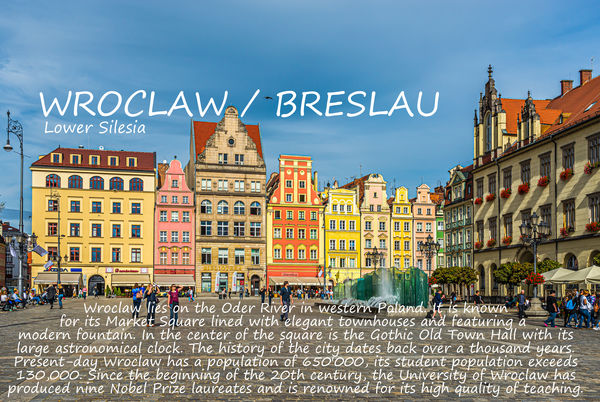
(Download)
2 - Nicely decorated facade of the La Maddalena restaurant opposite our hotel
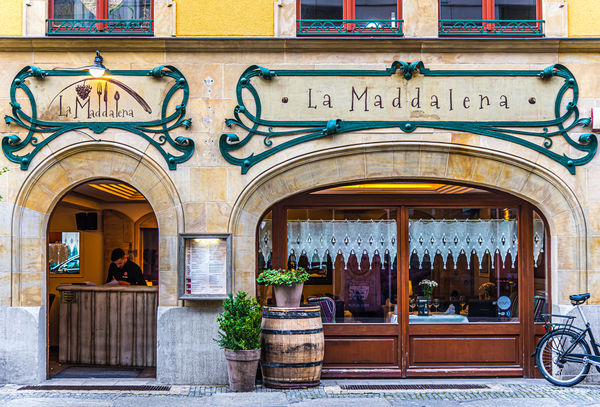
(Download)
3 - The "Old Town Promenade" along the City Moat of Wroclaw
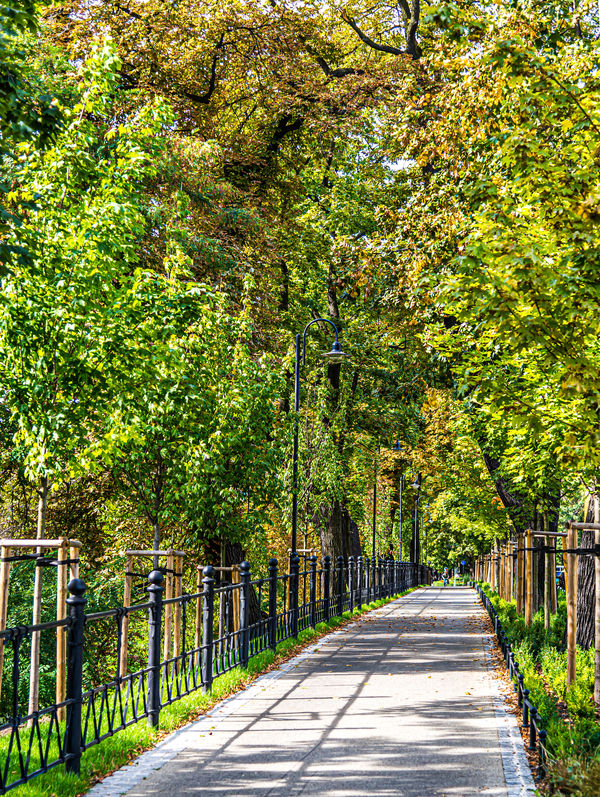
(Download)
4 - Fosa Miejska/City Moat of Wroclaw is largely based on natural and artificial sections of the Odra/Oder river, the existing green belt along the moat is called the Old Town Promenade
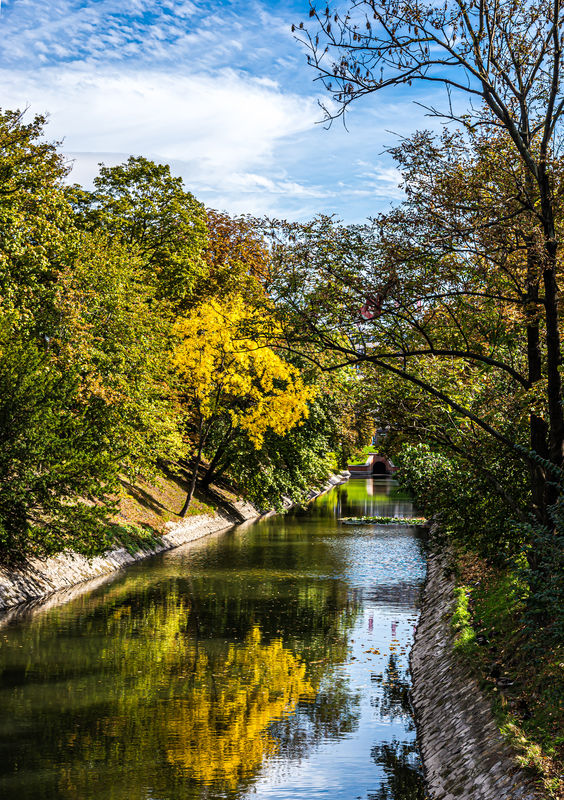
(Download)
5 - City Moat of Wroclaw with the District Court buildings
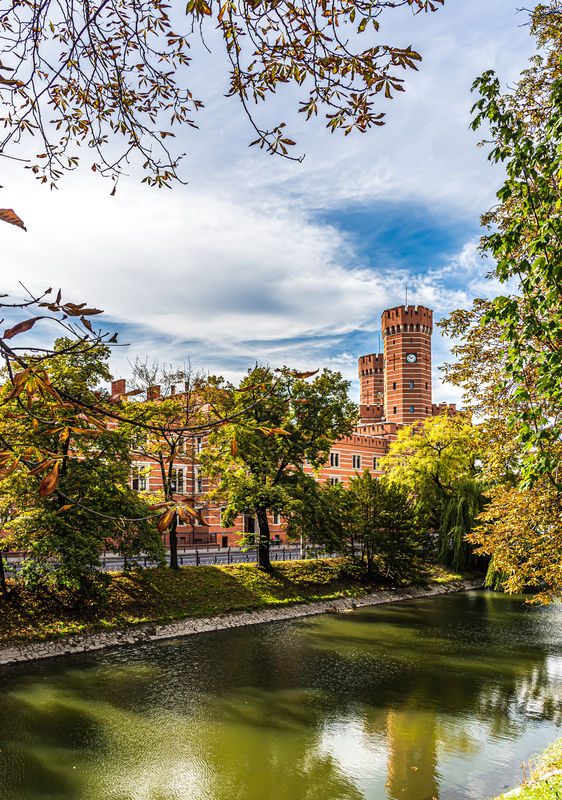
(Download)
6 - "Anonymous Pedestrians" sculpture group on Swidnicka & Pilsudskiego: At rear the pedestrians sink into the sidewalk, in front they emerge anew - interpreted as a symbol for people driven underground during martial law & then emerging into freedom
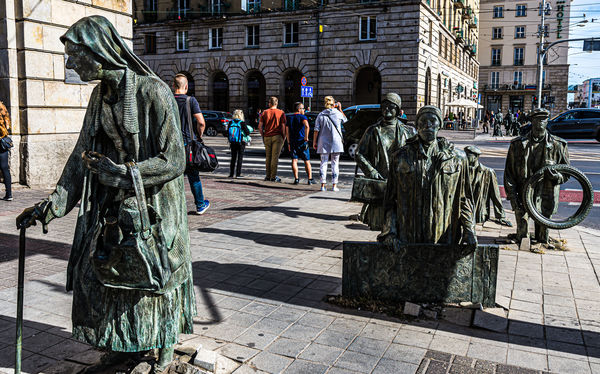
(Download)
7 - "Anonymous Pedestrians" group of sculptures - the "emerging" set
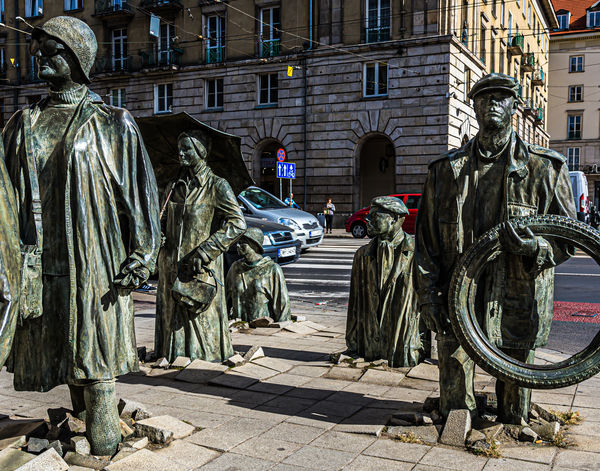
(Download)
8 - Corpus Christi church, first mentioned in 1351, by the Knights Hospitaller/Order of St John (Johanniter Orden), located on now busy Swidnicka Street
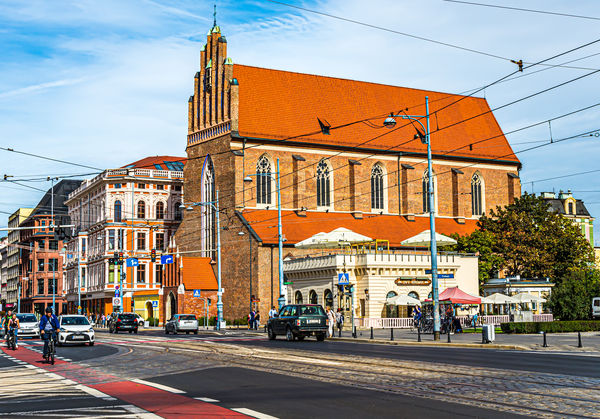
(Download)
9 - Wallenberg-Pachalych Palace (1787), over the centuries it has functioned as a family residence, bank and library and is presently seeking its next destiny
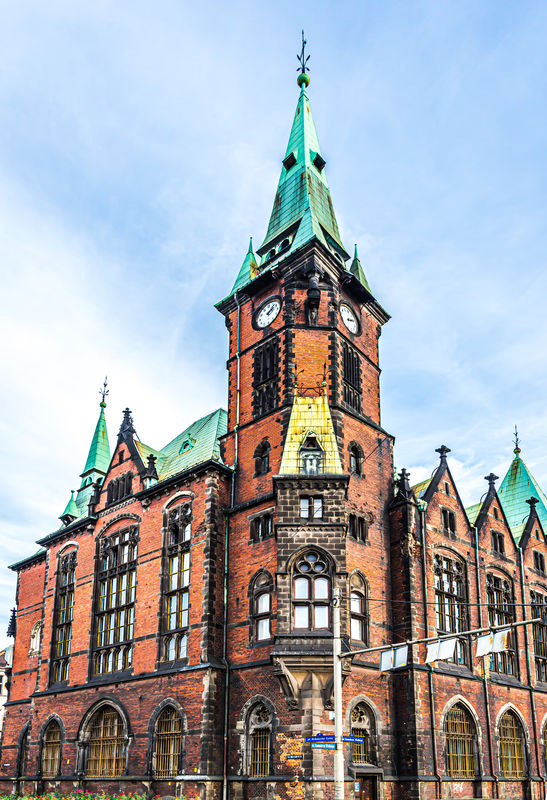
(Download)
10 - Looking onto Solny Square from the corner gate
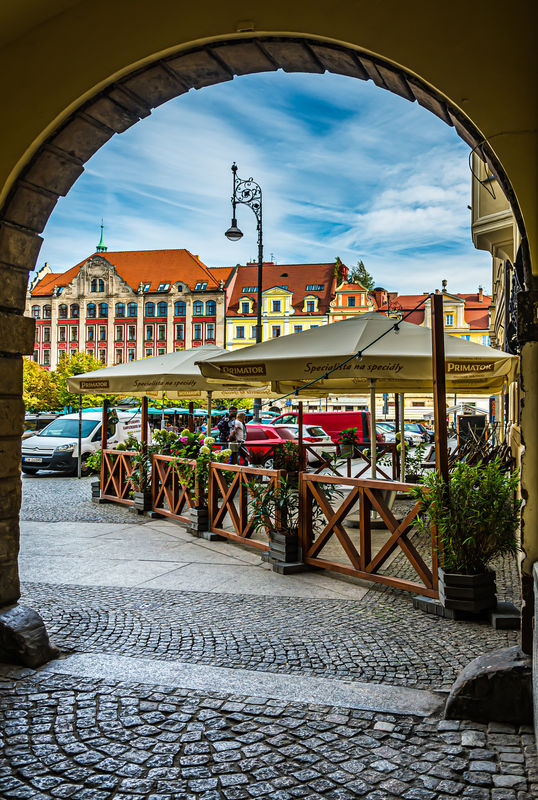
(Download)
Jul 2, 2021 11:06:22 #
Trip map of the Western Poland segment for your reference
Jul 2, 2021 11:11:47 #
Jul 2, 2021 11:14:38 #
Jul 2, 2021 11:45:41 #
lnl
Loc: SWFL
I too like the promenade and the moat photos. I can’t imagine how you functioned so well photographing these pictures while you were sick! I’m glad you have the memories as I imagine it might be difficult to remember some of your travels when you were feeling miserable.
The statue is interesting, even including broken pavement where the people are going “down” and back “up”.
The statue is interesting, even including broken pavement where the people are going “down” and back “up”.
Jul 2, 2021 11:49:10 #
Jul 2, 2021 11:53:24 #
Jul 2, 2021 12:00:02 #
UTMike wrote:
For a sick guy you did good work, Joe. I like those moat shots.
Thank you Mike - the show must go on, since I was all the way up there in this beautiful corner of Poland, I wan't going to let anything stop me from taking my pictures.
Jul 2, 2021 12:00:24 #
Jul 2, 2021 12:01:57 #
lnl wrote:
I too like the promenade and the moat photos. I can’t imagine how you functioned so well photographing these pictures while you were sick! I’m glad you have the memories as I imagine it might be difficult to remember some of your travels when you were feeling miserable.
The statue is interesting, even including broken pavement where the people are going “down” and back “up”.
The statue is interesting, even including broken pavement where the people are going “down” and back “up”.
Thank you Ellen, glad to hear that you like the green moat area, I also thought that these sculpture groups were quite interesting in their concept and execution.
Jul 2, 2021 12:03:43 #
NMGal wrote:
You did good, Joe. Very interesting.
Thank you Barbara, glad you found this set interesting. Wroclaw does not show much of the "painted facades" effect that was so dominant in our last city Poznan, but we did very much enjoy the architectural scenes in this city.
Jul 2, 2021 12:04:35 #
Doddy wrote:
Great shots and narrative Joe.
Thank you Doddy, it is nice to see you again looking in on the tour and your kind words!
Jul 2, 2021 13:05:08 #
Jul 2, 2021 13:06:01 #
Jul 2, 2021 13:29:45 #
angler wrote:
Superb set Joe.
Thank you Jim, glad to hear that you like this set!
If you want to reply, then register here. Registration is free and your account is created instantly, so you can post right away.


